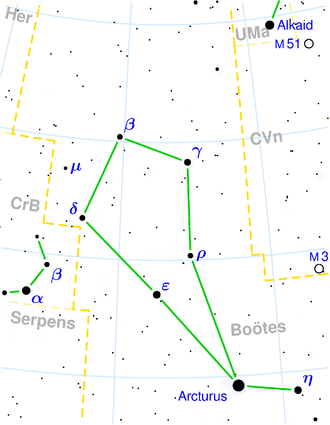IC 1009
| Galaxie IC 1009 | |
|---|---|
 | |
| SDSS-Aufnahme von IC 1009 | |
| AladinLite | |
| Sternbild | Bärenhüter |
| Position Äquinoktium: J2000.0, Epoche: J2000.0 | |
| Rektaszension | 14h 26m 17,6s[1] |
| Deklination | +12° 21′ 11″[1] |
| Erscheinungsbild | |
| Morphologischer Typ | S[2] |
| Helligkeit (visuell) | 14,5 mag[2] |
| Helligkeit (B-Band) | 15,3 mag[2] |
| Winkelausdehnung | 0,70' × 0,4'[2] |
| Positionswinkel | 60°[2] |
| Flächenhelligkeit | 13,0 mag/arcmin²[2] |
| Physikalische Daten | |
| Rotverschiebung | 0,025916 ± 0,000165[1] |
| Radialgeschwindigkeit | (7769 ± 49) km/s[1] |
| Hubbledistanz vrad / H0 | (348 ± 24) · 106 Lj (106,7 ± 7,5) Mpc [1] |
| Geschichte | |
| Entdeckung | Stéphane Javelle |
| Entdeckungsdatum | 17. Juni 1892 |
| Katalogbezeichnungen | |
| IC 1009 • PGC 51546 • CGCG 075-030 • MCG +02-37-007 • 2MASX J14261759+1221108 • GALEXASC J142617.50+122110.9 | |
IC 1009 ist eine Spiralgalaxie vom Hubble-Typ S im Sternbild Bärenhüter am Nordsternhimmel. Sie ist schätzungsweise 348 Millionen Lichtjahre von der Milchstraße entfernt und hat einen Durchmesser von etwa 70.000 Lj.
Das Objekt wurde am 17. Juni 1892 vom französischen Astronomen Stéphane Javelle entdeckt.[3]
Weblinks
Einzelnachweise
Auf dieser Seite verwendete Medien
Autor/Urheber: Sloan Digital Sky Survey, Lizenz: CC BY 4.0
The sky image is obtained by Sloan Digital Sky Survey, DR14 with SciServer.
Angle of view: 4' × 4' (0.3" per pixel), north is up.
Details on the image processing pipeline: https://www.sdss.org/dr14/imaging/jpg-images-on-skyserver/



